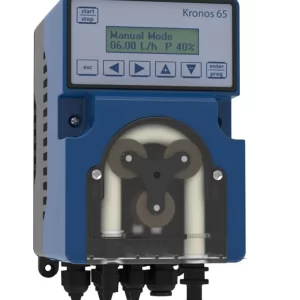Maintaining the right pH level is essential in drinking water and wastewater treatment systems to optimise efficiency, protect equipment and safeguard the environment and public health.
Drinking water and wastewater treatment systems play a crucial role in ensuring healthy communities and ecosystems. A key parameter that significantly influences the efficiency and performance of these treatment systems is the pH level of the treated water. The pH level affects both the chemical and physical properties of the water, thus influencing the behaviour of pollutants and the treatment processes.
Operators must have a thorough understanding of how pH influences treatment processes to ensure that these systems function as intended and to avoid potential damage to equipment, people and the environment.
Understanding pH
A simple definition is that it measures how acidic or basic a solution is.
A more scientific definition is that it indicates the concentration of hydrogen ions in a liquid. While a low pH indicates a higher concentration of hydrogen, a high pH indicates a lower concentration.
For those with a knowledge of chemistry, you can calculate the pH of any substance by calculating: pH = - log[H+].
PH in water
The pH of water is a measure of its acidity or alkalinity and is defined on a logarithmic scale from 0 to 14. A pH of 7 is considered neutral. Values below 7 indicate acidity and values above 7 indicate alkalinity. Fluctuations in pH are normal, but should generally be limited to between 6.3 and 7.6. When the pH moves above or below desired levels, operators may need to add chemicals to bring the levels back within the acceptable range.
The acidic water can be adjusted, for example, by adding sodium hydroxide using a chemical dosing pump (Figure 1).
Conversely, alkaline water can be controlled by adding liquid acids or carbon dioxide (CO2).
Figure 1. Metering pumps for chemicals (https://prodos.es/producto/bombas-dosificadoras-peristalticas-seko-kronos-50-y-65/). Peristaltic dosing pumps excel at dosing a wide range of chemicals.
Processes affected by pH
Coagulation and flocculation
In large water treatment plants, coagulation and flocculation are key treatment steps. Maintaining the pH within a specific range (usually between 6 and 8) helps to optimise coagulant performance and favours the formation of larger, settleable flocs. Deviations from the optimum pH range can lead to incomplete flocculation, poor sedimentation and reduced efficiency of subsequent filtration processes.
Disinfection
Disinfection is a crucial step in water treatment that removes harmful micro-organisms to ensure the safety of the water supply. Chlorine-based disinfectants work most effectively at pH values between 5.5 and 7.6. The pH level must be carefully monitored and adjusted to ensure adequate disinfection and to prevent the growth of germs and to avoid the formation of disinfection by-products, such as trihalomethanes (THMs), which are more likely to form at higher pH levels.
Collection and distribution
The pH of water also plays a crucial role in maintaining the integrity of wastewater collection systems and drinking water distribution systems. For this reason, many industries are required to treat their wastewater before discharge, including pH adjustment. When water is too acidic it can lead to corrosion of components in pumping and distribution systems. On the other hand, scaling occurs when water has a high pH and contains high levels of minerals such as calcium and magnesium, causing their deposition on pipes and fittings.
Biological processes
Biological processes such as activated sludge treatment or biological filtration are used in wastewater treatment systems to remove organic matter and nutrients. The pH level influences the activity and growth of the micro-organisms involved in these processes. Different microorganisms thrive in different pH ranges, and maintaining the right pH conditions is crucial for the stability and effectiveness of biological treatment systems.
Agriculture
In agriculture, pH is closely linked to the bioavailability of certain nutrients. Bioavailability means that some nutrients may be present in the soil but not available to plants if the pH varies beyond a certain range.
How to measure and adjust pH
Operators can measure pH with any in-line probe or, for more comprehensive analysis and data collection, with a water analyser (Figure 2), designed to measure pH levels.
When pH levels need to be adjusted, many facilities opt for chemical treatment using chemical dosing pumps. System designers and operators must take care to choose the correct pump for the chemical to be dosed. This includes choosing the right materials for the pump components, including valves, seals and pump tubing/hoses. They should be compatible with either acidic or basic liquids, depending on the type of product to be used.
Figure 2. Chemitec 30-series analyser (link to the shop) provides accurate real-time measurement, display and logging of pH and temperature data.
The chemical dosing pumps of the Seko Tekba-R series (https://prodos.es/producto/seko-tekba-r-emg/) provide smooth and precise chemical dosing thanks to their mechanical stroke length regulation. They are designed for the most demanding industrial applications thanks to their robust construction. It also has multiple modes for dosing regulation: manual, proportional to analogue or digital input, timed and proportional to ppm.
On the other hand, operators must be very aware of the type of acid or base used to adjust the pH. For example, sulphuric acid can quickly and drastically reduce the pH, but it also produces high levels of heat when mixed with water, which can be problematic and even dangerous in some applications.
Finally, it is essential to choose a suitable pH probe (Figure 3). Depending on the conditions of use (such as the type of product to be dosed, the temperature, the pressure or the conductivity), there are several types of pH probes available on the market (https://prodos.es/producto/sonda-electrodo-de-ph/). For example, there are probes with polycarbonate or glass body, with single or double membrane, high temperature resistant, hydrofluoric acid resistant, etc.
Regardless of which treatment method is used, the fact remains that the pH level plays an important role in all phases of water and wastewater treatment. By recognising the impact of pH and implementing appropriate control strategies, operators can ensure consistent treatment results.








